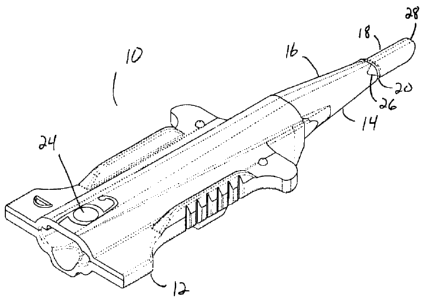Some of the information on this Web page has been provided by external sources. The Government of Canada is not responsible for the accuracy, reliability or currency of the information supplied by external sources. Users wishing to rely upon this information should consult directly with the source of the information. Content provided by external sources is not subject to official languages, privacy and accessibility requirements.
Any discrepancies in the text and image of the Claims and Abstract are due to differing posting times. Text of the Claims and Abstract are posted:
| (12) Patent: | (11) CA 2623752 |
|---|---|
| (54) English Title: | LENS DELIVERY SYSTEM CARTRIDGE AND METHOD OF MANUFACTURE |
| (54) French Title: | CARTOUCHE DE SYSTEME DE PRESENTATION DE LENTILLES ET SA METHODE DE FABRICATION |
| Status: | Deemed expired |
| (51) International Patent Classification (IPC): |
|
|---|---|
| (72) Inventors : |
|
| (73) Owners : |
|
| (71) Applicants : |
|
| (74) Agent: | KIRBY EADES GALE BAKER |
| (74) Associate agent: | |
| (45) Issued: | 2011-01-04 |
| (22) Filed Date: | 2008-02-29 |
| (41) Open to Public Inspection: | 2008-10-11 |
| Examination requested: | 2008-02-29 |
| Availability of licence: | N/A |
| (25) Language of filing: | English |
| Patent Cooperation Treaty (PCT): | No |
|---|
| (30) Application Priority Data: | ||||||
|---|---|---|---|---|---|---|
|
A cartridge for an IOL delivery system that has a straight thinned walled distal nozzle. The transition region between the tapered folding portion of the cartridge and the nozzle contain reinforcing gussets to help prevent splitting of the cartridge. Flow leaders in the nozzle direct the flow of material during molding at the 12:00 o'clock position, positioning the weld line of the flow front at the 6:00 o'clock position.
Une cartouche pour un système d'introduction de LIO contenant un injecteur distal droit à paroi mince. La région transitoire entre la portion pliable effilée de la cartouche et l'injecteur contient des goussets de renfort qui aident à prévenir la séparation de la cartouche. Des canaux de séparation dans l'injecteur dirigent l'écoulement de matière pendant le moulage à la position 12 heures, la position de la ligne de soudure du front d'écoulement se trouvant à 6 heures.
Note: Claims are shown in the official language in which they were submitted.
Note: Descriptions are shown in the official language in which they were submitted.

For a clearer understanding of the status of the application/patent presented on this page, the site Disclaimer , as well as the definitions for Patent , Administrative Status , Maintenance Fee and Payment History should be consulted.
| Title | Date |
|---|---|
| Forecasted Issue Date | 2011-01-04 |
| (22) Filed | 2008-02-29 |
| Examination Requested | 2008-02-29 |
| (41) Open to Public Inspection | 2008-10-11 |
| (45) Issued | 2011-01-04 |
| Deemed Expired | 2020-03-02 |
There is no abandonment history.
| Fee Type | Anniversary Year | Due Date | Amount Paid | Paid Date |
|---|---|---|---|---|
| Request for Examination | $800.00 | 2008-02-29 | ||
| Application Fee | $400.00 | 2008-02-29 | ||
| Maintenance Fee - Application - New Act | 2 | 2010-03-01 | $100.00 | 2010-02-05 |
| Final Fee | $300.00 | 2010-10-20 | ||
| Maintenance Fee - Patent - New Act | 3 | 2011-02-28 | $100.00 | 2011-01-31 |
| Maintenance Fee - Patent - New Act | 4 | 2012-02-29 | $100.00 | 2012-01-30 |
| Maintenance Fee - Patent - New Act | 5 | 2013-02-28 | $200.00 | 2013-01-09 |
| Maintenance Fee - Patent - New Act | 6 | 2014-02-28 | $200.00 | 2014-01-08 |
| Maintenance Fee - Patent - New Act | 7 | 2015-03-02 | $200.00 | 2015-02-04 |
| Maintenance Fee - Patent - New Act | 8 | 2016-02-29 | $200.00 | 2016-02-04 |
| Maintenance Fee - Patent - New Act | 9 | 2017-02-28 | $200.00 | 2017-02-08 |
| Maintenance Fee - Patent - New Act | 10 | 2018-02-28 | $250.00 | 2018-02-07 |
| Maintenance Fee - Patent - New Act | 11 | 2019-02-28 | $250.00 | 2019-02-07 |
| Registration of a document - section 124 | 2019-12-18 | $100.00 | 2019-12-18 | |
| Registration of a document - section 124 | 2019-12-18 | $100.00 | 2019-12-18 |
Note: Records showing the ownership history in alphabetical order.
| Current Owners on Record |
|---|
| ALCON INC. |
| Past Owners on Record |
|---|
| ALCON, INC. |
| BROWN, KYLE |
| DOWNER, DAVID A. |
| MUCHHALA, SUSHANT |
| NOVARTIS AG |
| TRAN, TU CAM |
| YAN, DENGZHU |